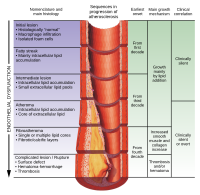
Photo from wikipedia
Background Aortic arch calcification (AoAC) is associated with plaque development and cardiovascular events. We aimed to estimate the predictive value of AoAC for stroke recurrence in patients with embolic stroke… Click to show full abstract
Background Aortic arch calcification (AoAC) is associated with plaque development and cardiovascular events. We aimed to estimate the predictive value of AoAC for stroke recurrence in patients with embolic stroke of undetermined source (ESUS). Methods Consecutive patients with ESUS who were admitted to our center between October 2019 and October 2020 and who had a 1-year follow-up of stroke recurrence were retrospectively reviewed. According to our AoAC grading scale (AGS), AoAC was classified into four grades based on chest computed tomography (CT) findings: no visible calcification (grade 0), spotty calcification (grade 1), lamellar calcification (grade 2), and circular calcification (grade 3). Results Of the 158 patients with ESUS (age, 62.1 ± 14.5 years; 120 men) enrolled, 24 (15.2%) had recurrent stroke within a 1-year follow-up. The Cox regression analysis showed that stroke history [hazard ratio (HR), 4.625; 95% confidence interval (CI), 1.828–11.700, p = 0.001] and AoAC (HR, 2.672; 95% CI, 1.129–6.319; p = 0.025) predicted recurrent stroke. AGS grade 1 was associated with a significantly higher risk of stroke recurrence than AGS grade 0 (HR, 5.033; 95% CI, 1.858–13.635, p = 0.001) and AGS grade 2 plus 3 (HR, 3.388; 95% CI, 1.124–10.206, p = 0.030). In patients with AoAC, receiver operating characteristic (ROC) analysis showed that AGS had a good value in predicting stroke recurrence in patients with ESUS, with an area under curve (AUC) of 0.735 (95% CI = 0.601–0.869, p = 0.005). Conclusions Aortic arch calcification, especially spotty calcification, had a good predictive value for stroke recurrence in patients with ESUS.
Journal Title: Frontiers in Neurology
Year Published: 2022
Link to full text (if available)
Share on Social Media: Sign Up to like & get
recommendations!